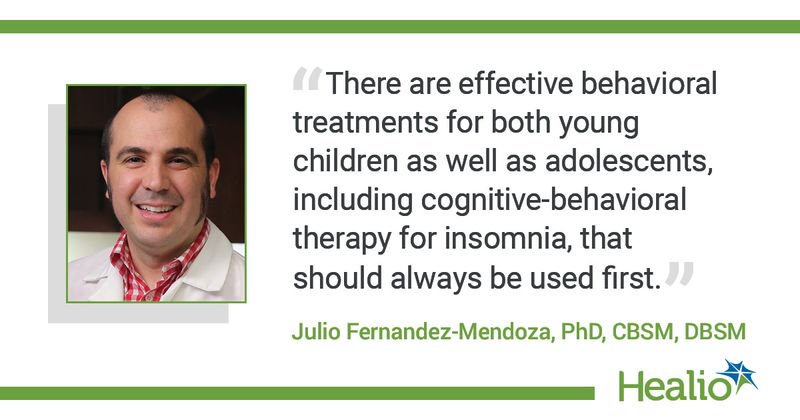Q&A: ‘Insomnia is a persistent problem’ for kids
Click Here to Manage Email Alerts
By some estimates, 52% of youths may experience insomnia symptoms at some point during their childhood. However, there are “notable limitations” in the current medical literature, experts wrote in Sleep.
To help fill in some of the research gaps, Julio Fernandez-Mendoza, PhD, CBSM, DBSM, an associate professor of psychiatry at the Sleep Research & Treatment Center at the Penn State University College of Medicine, and colleagues examined the natural history of insomnia symptoms in the transition from childhood to adolescence in a random, general population sample of 421 youths for an average of 7.8 years. The mean age of the youths was 8.8 years at baseline and 17 years at follow-up; 53.9% of the participants were male, and 21.9% were from underrepresented racial groups.

In an interview with Healio Primary Care, Fernandez-Mendoza discussed some of the study’s findings, how primary care physicians can screen for childhood insomnia, why sociodemographic factors are important to consider, treatment options and more.
Q: What are the most important unanswered questions regarding childhood insomnia?
A: As of today, and beyond our study, one of the most important unanswered questions is the relative contribution of behavioral vs. biological factors in the etiology and pathophysiology of childhood insomnia. In other words, although for many children insomnia is behavioral in nature, such as resisting going to bed or needing the presence of an adult to fall asleep, in some children insomnia does share the same underlying mechanisms with adult insomnia, and these have not been disentangled yet.
Q: What are the most effective ways that PCPs can screen for insomnia in children?
A: Asking very straightforward 1-minute questions to both the parent and the child on whether they have difficulty falling asleep and/or difficulty staying asleep. In addition, screening for other sleep symptoms, such as loud snoring, daytime sleepiness, difficulty waking up in the morning and restless sleep can also help determine whether the child will receive appropriate care or referral so their sleep issues do not go untreated.
Q: What evidence from your study suggests that insomnia is more than a “transient phenomenon” in most children? Why is it important to recognize this?
A: Only 30% of young children with insomnia are fully remitted by adolescence, which means that insomnia is a persistent problem during this developmental period associated with biological and psychosocial changes. In our study, we point toward specific social determinants and clinical conditions that contribute to such persistence, including childhood behavioral, mood and neurological disorders, childhood obesity and adolescence substance use.
Q: What are some effective integrative and behavioral therapies for childhood insomnia?
A: Most cases of childhood insomnia can be effectively treated with behavioral therapies, such as use of bedtime pass, bedtime fading or graduated extinction. Pediatric behavioral sleep medicine specialists are best equipped to provide these services; however, there are standard protocols that can be disseminated and implemented in primary care with adequate consultation.
Q: Why are sociodemographic factors important to the understanding childhood insomnia ?
A: Females, racial/ethnic minorities and those of low socioeconomic households had a greater risk of persisting or developing insomnia in the transition from childhood to adolescence. Specifically, in 75% of children who identified as a racial/ethnic minority, primarily Black, their insomnia continued to persist in the transition to adolescence. Socioeconomic status also played a role: children who identified as a racial/ethnic minority and children who identified as non-Hispanic white and lived in low socioeconomic households were 7 and 2.5 times more likely, respectively, to not fully remit from their insomnia in the transition to adolescence as compared to children who identified as non-Hispanic white and lived in higher socioeconomic households.
These findings are an indicator that social determinants of health, arising from racial, gender and economic inequalities, also play a role in the chronicity of insomnia as early as childhood and, thus, PCPs should play close attention to these at-risk children and not regard their insomnia as an unimportant health problem that will naturally improve with development.
Q: When do you recommend pharmaceutical treatments for children with insomnia? What treatments are safe and effective in this population?
A: Pharmaceutical treatment is not recommended as a first-line therapy for insomnia in children.
There are effective behavioral treatments for both young children as well as adolescents, including cognitive-behavioral therapy for insomnia, that should always be used first. These treatments are evidence-based and not simply sleep hygiene education. We need to better integrate these therapeutic options at the front-line in primary care and pediatrics.
Pharmacological approaches in treatment-resistant insomnia in youth and in specific populations, such as those with neurodevelopmental disorders, are similar to those used in adults, except the more common approach of relying on over-the-counter melatonin. However, the latter is overused by providers and parents alike and requires better knowledge from the clinician as it is a compound that, if correctly formulated, can be a good chronobiotic (a drug that regulates the circadian clock) but not so much a good hypnotic (a drug that increases sleep).
